Business Research Methodology: Digital Gap in Australia
VerifiedAdded on 2021/04/24
|14
|3393
|90
Report
AI Summary
This report provides a comprehensive analysis of the digital gap between urban and sub-urban areas in Australia, examining the factors that contribute to this divide. The research framework is established by identifying both theoretical and empirical gaps, focusing on variables such as affordability, accessibility, gender, age, digital ability, income, and education. The study employs the Technology Acceptance Model (TAM) to illustrate the impact of these factors on ICT adoption and utilization. The research proposes a conceptual framework and several hypotheses to test the relationships between independent variables and the dependent variable, digital gap. The report also highlights the role of mediating variables, such as accessibility to ICT, in influencing the digital divide. The findings are supported by empirical evidence, including the Australian Digital Inclusion Index (ADII) and data from the Australian Bureau of Statistics (ABS), which reveal trends in digital inclusion and the persistent disparities between urban and sub-urban areas. The report concludes with a justification of the variables and their significance in understanding and addressing the digital gap in Australia.
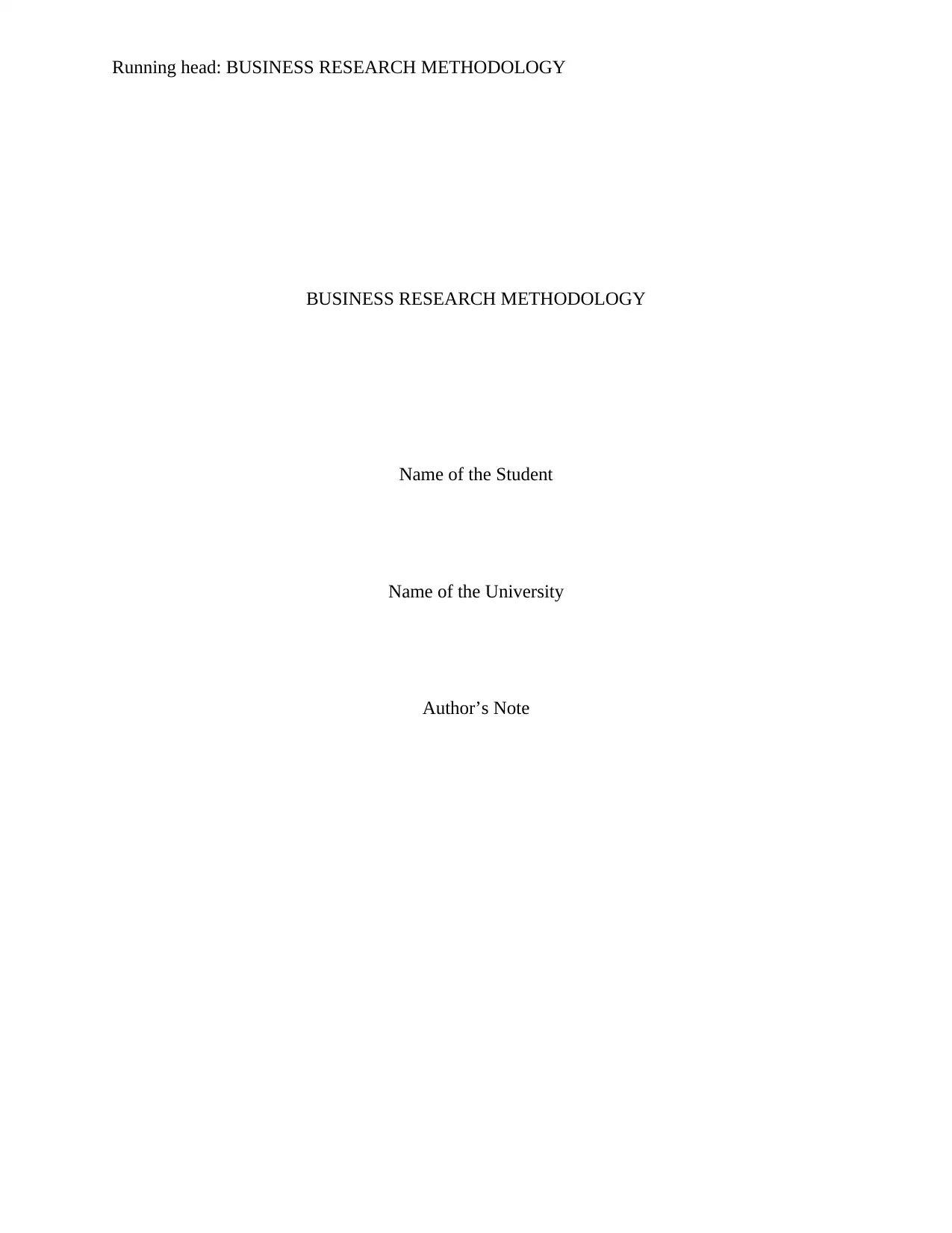
Running head: BUSINESS RESEARCH METHODOLOGY
BUSINESS RESEARCH METHODOLOGY
Name of the Student
Name of the University
Author’s Note
BUSINESS RESEARCH METHODOLOGY
Name of the Student
Name of the University
Author’s Note
Paraphrase This Document
Need a fresh take? Get an instant paraphrase of this document with our AI Paraphraser
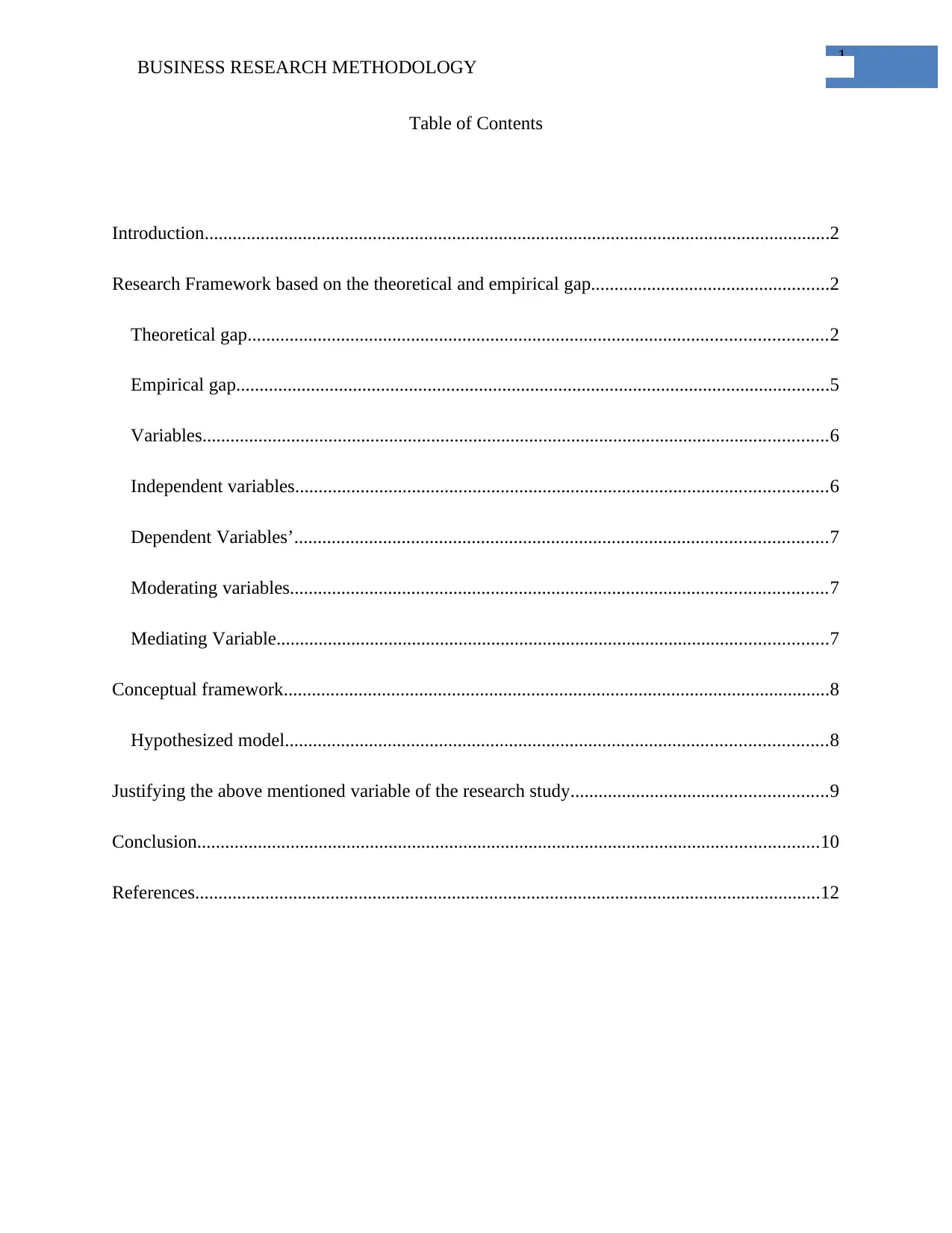
1
BUSINESS RESEARCH METHODOLOGY
Table of Contents
Introduction......................................................................................................................................2
Research Framework based on the theoretical and empirical gap...................................................2
Theoretical gap............................................................................................................................2
Empirical gap...............................................................................................................................5
Variables......................................................................................................................................6
Independent variables..................................................................................................................6
Dependent Variables’..................................................................................................................7
Moderating variables...................................................................................................................7
Mediating Variable......................................................................................................................7
Conceptual framework.....................................................................................................................8
Hypothesized model....................................................................................................................8
Justifying the above mentioned variable of the research study.......................................................9
Conclusion.....................................................................................................................................10
References......................................................................................................................................12
BUSINESS RESEARCH METHODOLOGY
Table of Contents
Introduction......................................................................................................................................2
Research Framework based on the theoretical and empirical gap...................................................2
Theoretical gap............................................................................................................................2
Empirical gap...............................................................................................................................5
Variables......................................................................................................................................6
Independent variables..................................................................................................................6
Dependent Variables’..................................................................................................................7
Moderating variables...................................................................................................................7
Mediating Variable......................................................................................................................7
Conceptual framework.....................................................................................................................8
Hypothesized model....................................................................................................................8
Justifying the above mentioned variable of the research study.......................................................9
Conclusion.....................................................................................................................................10
References......................................................................................................................................12
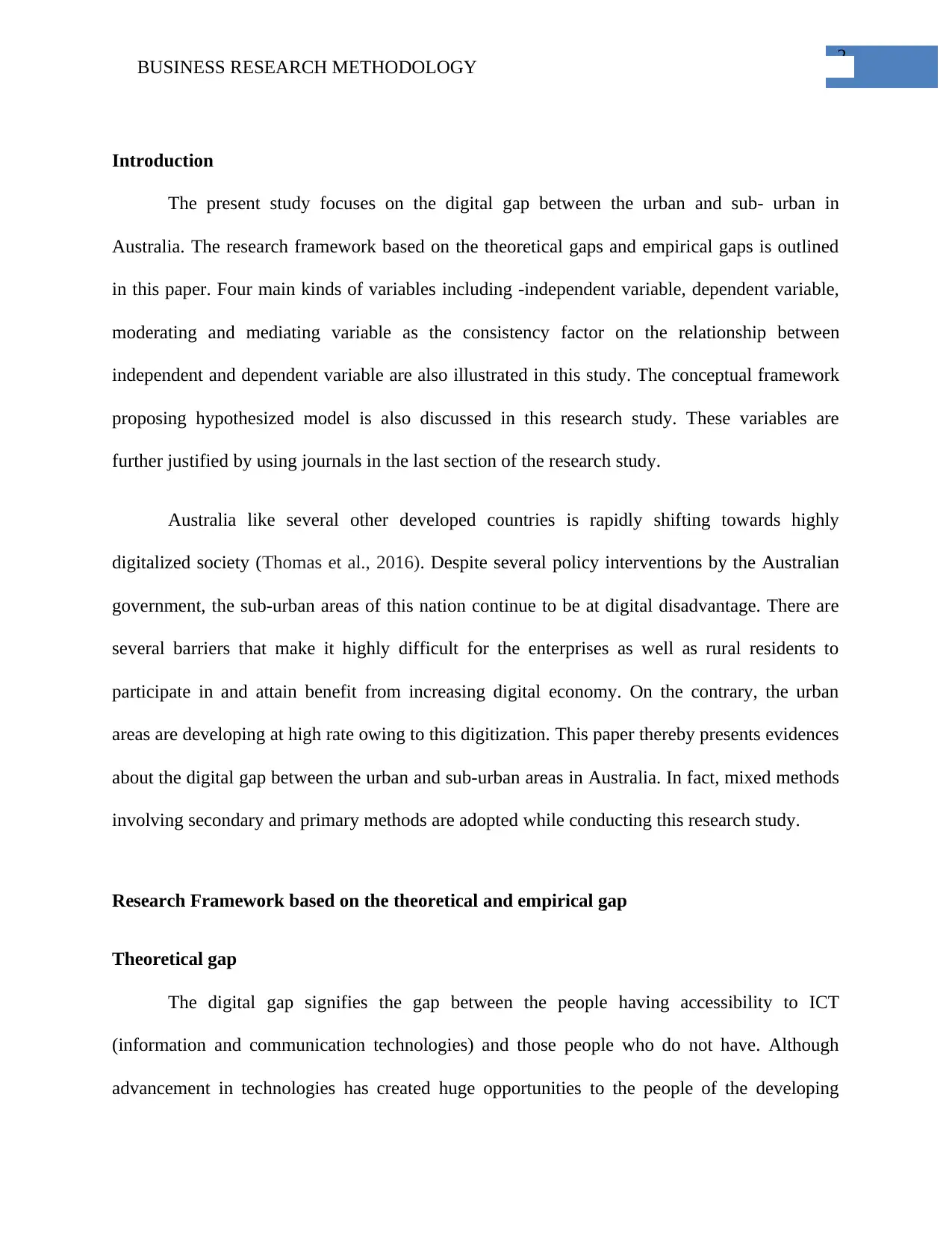
2
BUSINESS RESEARCH METHODOLOGY
Introduction
The present study focuses on the digital gap between the urban and sub- urban in
Australia. The research framework based on the theoretical gaps and empirical gaps is outlined
in this paper. Four main kinds of variables including -independent variable, dependent variable,
moderating and mediating variable as the consistency factor on the relationship between
independent and dependent variable are also illustrated in this study. The conceptual framework
proposing hypothesized model is also discussed in this research study. These variables are
further justified by using journals in the last section of the research study.
Australia like several other developed countries is rapidly shifting towards highly
digitalized society (Thomas et al., 2016). Despite several policy interventions by the Australian
government, the sub-urban areas of this nation continue to be at digital disadvantage. There are
several barriers that make it highly difficult for the enterprises as well as rural residents to
participate in and attain benefit from increasing digital economy. On the contrary, the urban
areas are developing at high rate owing to this digitization. This paper thereby presents evidences
about the digital gap between the urban and sub-urban areas in Australia. In fact, mixed methods
involving secondary and primary methods are adopted while conducting this research study.
Research Framework based on the theoretical and empirical gap
Theoretical gap
The digital gap signifies the gap between the people having accessibility to ICT
(information and communication technologies) and those people who do not have. Although
advancement in technologies has created huge opportunities to the people of the developing
BUSINESS RESEARCH METHODOLOGY
Introduction
The present study focuses on the digital gap between the urban and sub- urban in
Australia. The research framework based on the theoretical gaps and empirical gaps is outlined
in this paper. Four main kinds of variables including -independent variable, dependent variable,
moderating and mediating variable as the consistency factor on the relationship between
independent and dependent variable are also illustrated in this study. The conceptual framework
proposing hypothesized model is also discussed in this research study. These variables are
further justified by using journals in the last section of the research study.
Australia like several other developed countries is rapidly shifting towards highly
digitalized society (Thomas et al., 2016). Despite several policy interventions by the Australian
government, the sub-urban areas of this nation continue to be at digital disadvantage. There are
several barriers that make it highly difficult for the enterprises as well as rural residents to
participate in and attain benefit from increasing digital economy. On the contrary, the urban
areas are developing at high rate owing to this digitization. This paper thereby presents evidences
about the digital gap between the urban and sub-urban areas in Australia. In fact, mixed methods
involving secondary and primary methods are adopted while conducting this research study.
Research Framework based on the theoretical and empirical gap
Theoretical gap
The digital gap signifies the gap between the people having accessibility to ICT
(information and communication technologies) and those people who do not have. Although
advancement in technologies has created huge opportunities to the people of the developing
⊘ This is a preview!⊘
Do you want full access?
Subscribe today to unlock all pages.

Trusted by 1+ million students worldwide
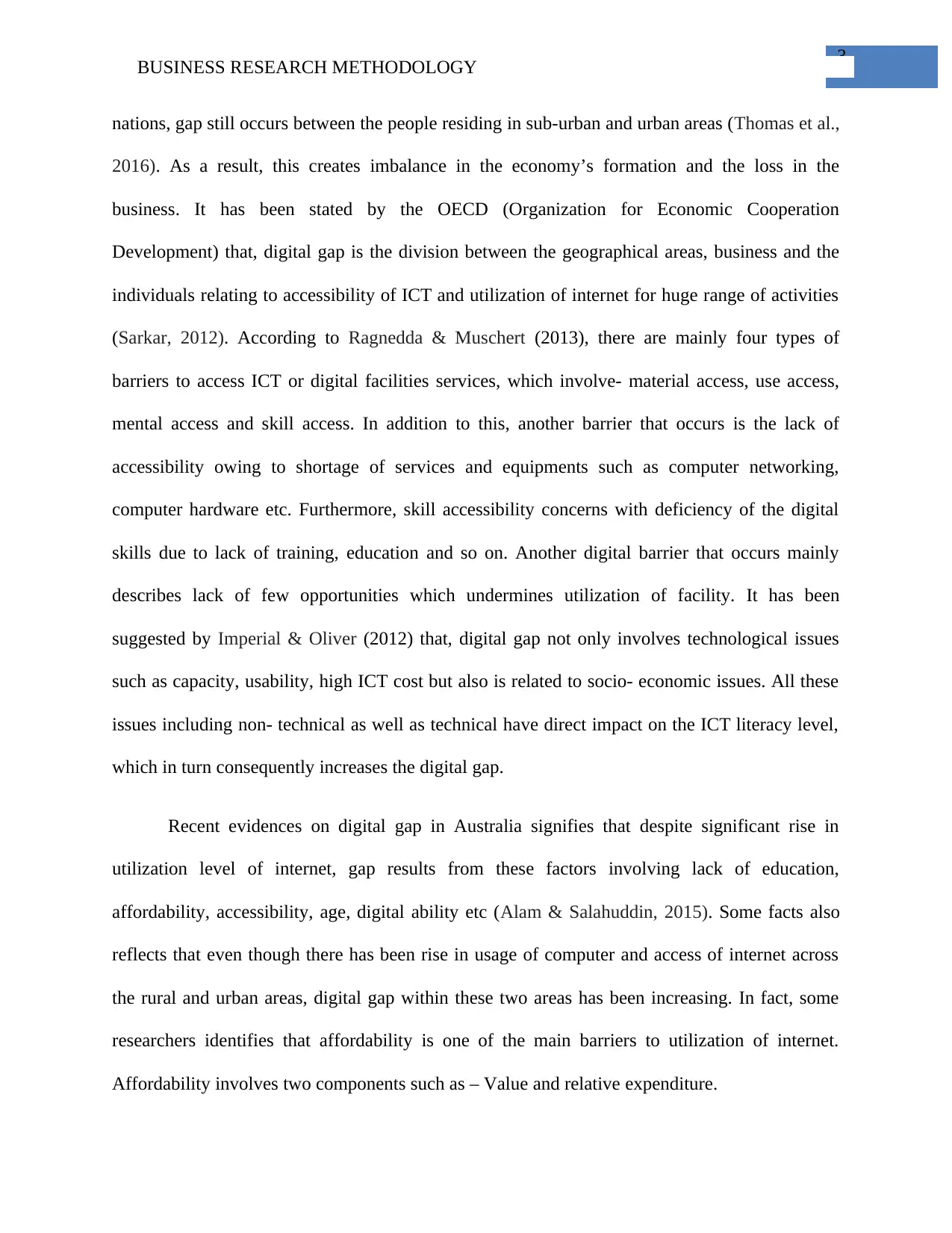
3
BUSINESS RESEARCH METHODOLOGY
nations, gap still occurs between the people residing in sub-urban and urban areas (Thomas et al.,
2016). As a result, this creates imbalance in the economy’s formation and the loss in the
business. It has been stated by the OECD (Organization for Economic Cooperation
Development) that, digital gap is the division between the geographical areas, business and the
individuals relating to accessibility of ICT and utilization of internet for huge range of activities
(Sarkar, 2012). According to Ragnedda & Muschert (2013), there are mainly four types of
barriers to access ICT or digital facilities services, which involve- material access, use access,
mental access and skill access. In addition to this, another barrier that occurs is the lack of
accessibility owing to shortage of services and equipments such as computer networking,
computer hardware etc. Furthermore, skill accessibility concerns with deficiency of the digital
skills due to lack of training, education and so on. Another digital barrier that occurs mainly
describes lack of few opportunities which undermines utilization of facility. It has been
suggested by Imperial & Oliver (2012) that, digital gap not only involves technological issues
such as capacity, usability, high ICT cost but also is related to socio- economic issues. All these
issues including non- technical as well as technical have direct impact on the ICT literacy level,
which in turn consequently increases the digital gap.
Recent evidences on digital gap in Australia signifies that despite significant rise in
utilization level of internet, gap results from these factors involving lack of education,
affordability, accessibility, age, digital ability etc (Alam & Salahuddin, 2015). Some facts also
reflects that even though there has been rise in usage of computer and access of internet across
the rural and urban areas, digital gap within these two areas has been increasing. In fact, some
researchers identifies that affordability is one of the main barriers to utilization of internet.
Affordability involves two components such as – Value and relative expenditure.
BUSINESS RESEARCH METHODOLOGY
nations, gap still occurs between the people residing in sub-urban and urban areas (Thomas et al.,
2016). As a result, this creates imbalance in the economy’s formation and the loss in the
business. It has been stated by the OECD (Organization for Economic Cooperation
Development) that, digital gap is the division between the geographical areas, business and the
individuals relating to accessibility of ICT and utilization of internet for huge range of activities
(Sarkar, 2012). According to Ragnedda & Muschert (2013), there are mainly four types of
barriers to access ICT or digital facilities services, which involve- material access, use access,
mental access and skill access. In addition to this, another barrier that occurs is the lack of
accessibility owing to shortage of services and equipments such as computer networking,
computer hardware etc. Furthermore, skill accessibility concerns with deficiency of the digital
skills due to lack of training, education and so on. Another digital barrier that occurs mainly
describes lack of few opportunities which undermines utilization of facility. It has been
suggested by Imperial & Oliver (2012) that, digital gap not only involves technological issues
such as capacity, usability, high ICT cost but also is related to socio- economic issues. All these
issues including non- technical as well as technical have direct impact on the ICT literacy level,
which in turn consequently increases the digital gap.
Recent evidences on digital gap in Australia signifies that despite significant rise in
utilization level of internet, gap results from these factors involving lack of education,
affordability, accessibility, age, digital ability etc (Alam & Salahuddin, 2015). Some facts also
reflects that even though there has been rise in usage of computer and access of internet across
the rural and urban areas, digital gap within these two areas has been increasing. In fact, some
researchers identifies that affordability is one of the main barriers to utilization of internet.
Affordability involves two components such as – Value and relative expenditure.
Paraphrase This Document
Need a fresh take? Get an instant paraphrase of this document with our AI Paraphraser
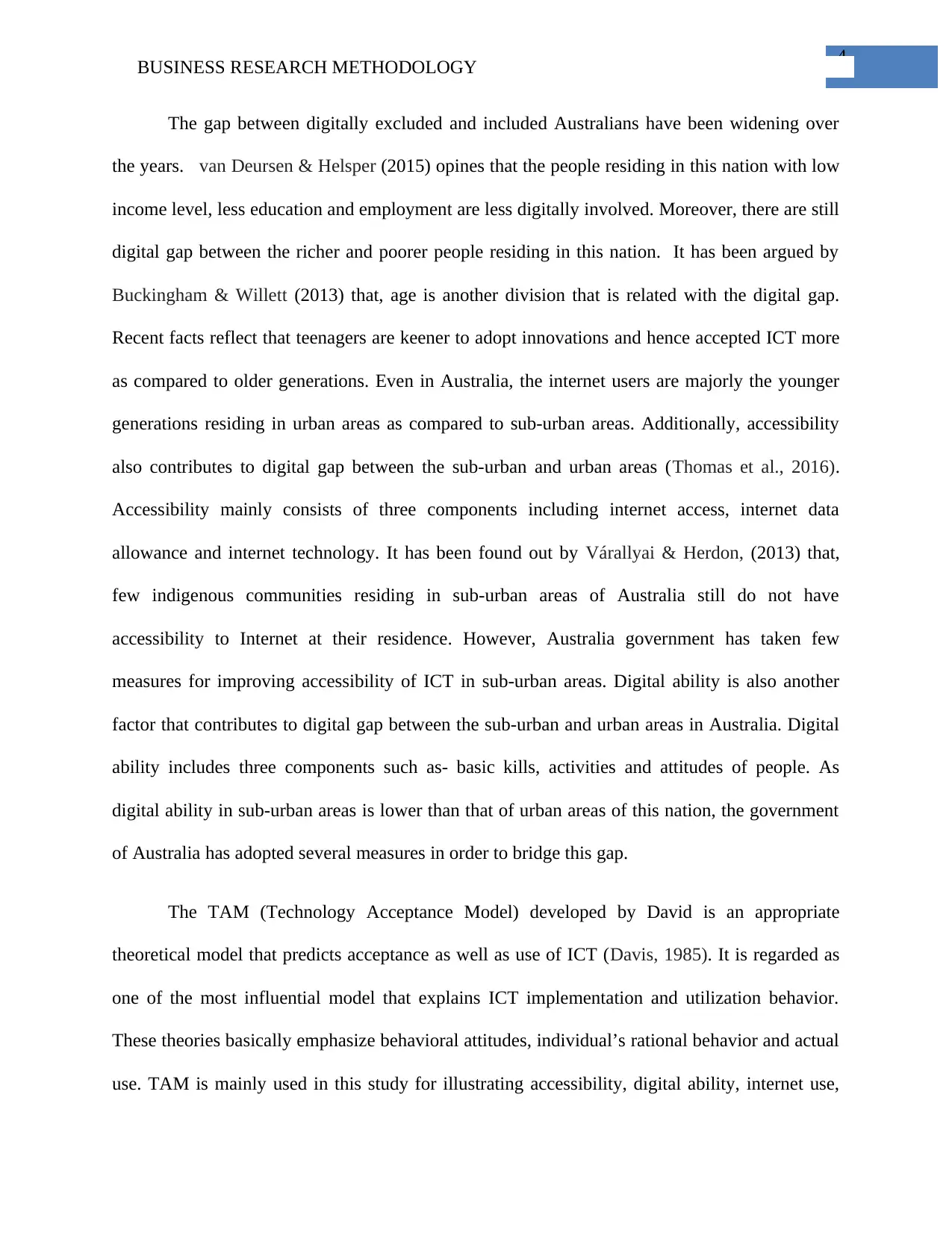
4
BUSINESS RESEARCH METHODOLOGY
The gap between digitally excluded and included Australians have been widening over
the years. van Deursen & Helsper (2015) opines that the people residing in this nation with low
income level, less education and employment are less digitally involved. Moreover, there are still
digital gap between the richer and poorer people residing in this nation. It has been argued by
Buckingham & Willett (2013) that, age is another division that is related with the digital gap.
Recent facts reflect that teenagers are keener to adopt innovations and hence accepted ICT more
as compared to older generations. Even in Australia, the internet users are majorly the younger
generations residing in urban areas as compared to sub-urban areas. Additionally, accessibility
also contributes to digital gap between the sub-urban and urban areas (Thomas et al., 2016).
Accessibility mainly consists of three components including internet access, internet data
allowance and internet technology. It has been found out by Várallyai & Herdon, (2013) that,
few indigenous communities residing in sub-urban areas of Australia still do not have
accessibility to Internet at their residence. However, Australia government has taken few
measures for improving accessibility of ICT in sub-urban areas. Digital ability is also another
factor that contributes to digital gap between the sub-urban and urban areas in Australia. Digital
ability includes three components such as- basic kills, activities and attitudes of people. As
digital ability in sub-urban areas is lower than that of urban areas of this nation, the government
of Australia has adopted several measures in order to bridge this gap.
The TAM (Technology Acceptance Model) developed by David is an appropriate
theoretical model that predicts acceptance as well as use of ICT (Davis, 1985). It is regarded as
one of the most influential model that explains ICT implementation and utilization behavior.
These theories basically emphasize behavioral attitudes, individual’s rational behavior and actual
use. TAM is mainly used in this study for illustrating accessibility, digital ability, internet use,
BUSINESS RESEARCH METHODOLOGY
The gap between digitally excluded and included Australians have been widening over
the years. van Deursen & Helsper (2015) opines that the people residing in this nation with low
income level, less education and employment are less digitally involved. Moreover, there are still
digital gap between the richer and poorer people residing in this nation. It has been argued by
Buckingham & Willett (2013) that, age is another division that is related with the digital gap.
Recent facts reflect that teenagers are keener to adopt innovations and hence accepted ICT more
as compared to older generations. Even in Australia, the internet users are majorly the younger
generations residing in urban areas as compared to sub-urban areas. Additionally, accessibility
also contributes to digital gap between the sub-urban and urban areas (Thomas et al., 2016).
Accessibility mainly consists of three components including internet access, internet data
allowance and internet technology. It has been found out by Várallyai & Herdon, (2013) that,
few indigenous communities residing in sub-urban areas of Australia still do not have
accessibility to Internet at their residence. However, Australia government has taken few
measures for improving accessibility of ICT in sub-urban areas. Digital ability is also another
factor that contributes to digital gap between the sub-urban and urban areas in Australia. Digital
ability includes three components such as- basic kills, activities and attitudes of people. As
digital ability in sub-urban areas is lower than that of urban areas of this nation, the government
of Australia has adopted several measures in order to bridge this gap.
The TAM (Technology Acceptance Model) developed by David is an appropriate
theoretical model that predicts acceptance as well as use of ICT (Davis, 1985). It is regarded as
one of the most influential model that explains ICT implementation and utilization behavior.
These theories basically emphasize behavioral attitudes, individual’s rational behavior and actual
use. TAM is mainly used in this study for illustrating accessibility, digital ability, internet use,
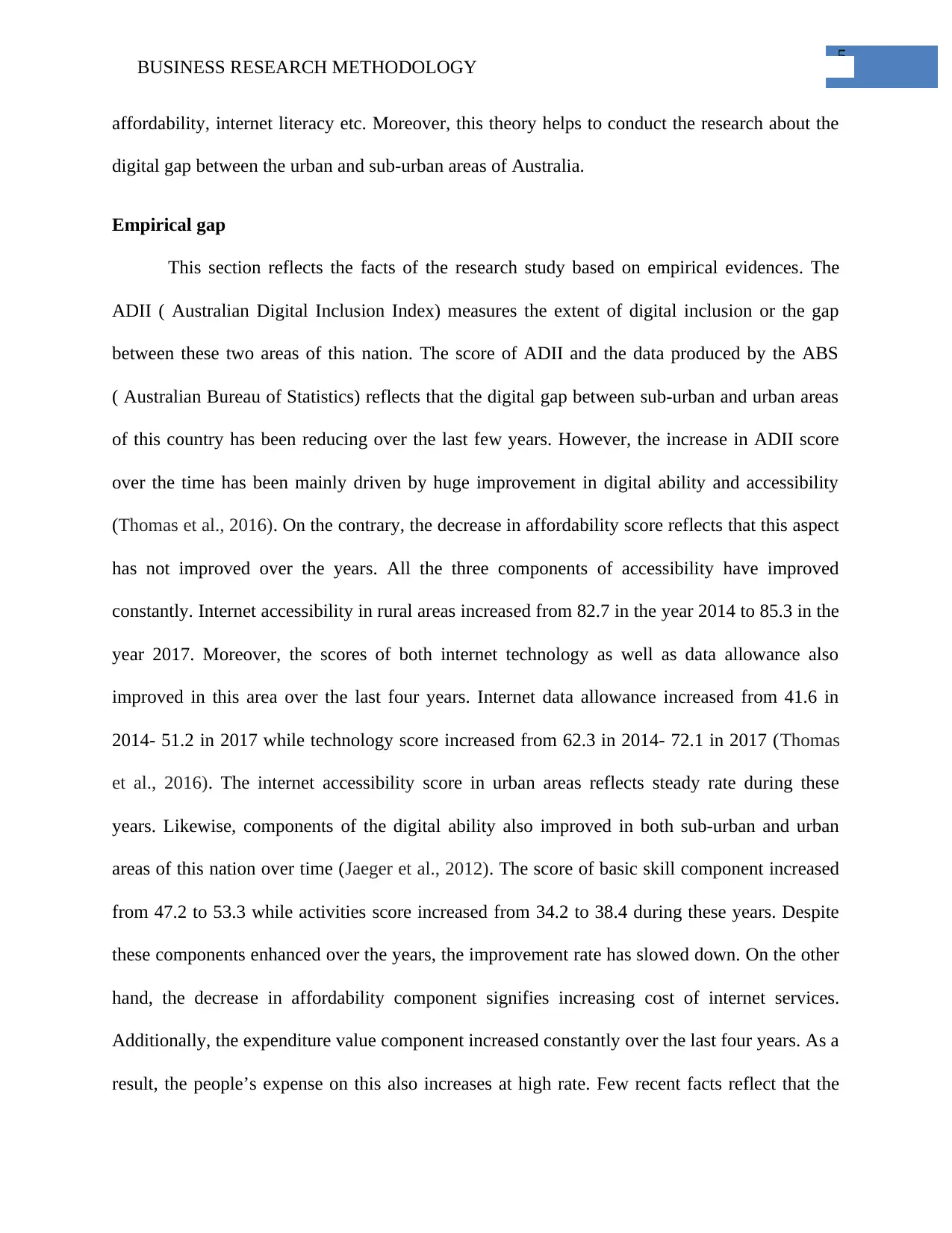
5
BUSINESS RESEARCH METHODOLOGY
affordability, internet literacy etc. Moreover, this theory helps to conduct the research about the
digital gap between the urban and sub-urban areas of Australia.
Empirical gap
This section reflects the facts of the research study based on empirical evidences. The
ADII ( Australian Digital Inclusion Index) measures the extent of digital inclusion or the gap
between these two areas of this nation. The score of ADII and the data produced by the ABS
( Australian Bureau of Statistics) reflects that the digital gap between sub-urban and urban areas
of this country has been reducing over the last few years. However, the increase in ADII score
over the time has been mainly driven by huge improvement in digital ability and accessibility
(Thomas et al., 2016). On the contrary, the decrease in affordability score reflects that this aspect
has not improved over the years. All the three components of accessibility have improved
constantly. Internet accessibility in rural areas increased from 82.7 in the year 2014 to 85.3 in the
year 2017. Moreover, the scores of both internet technology as well as data allowance also
improved in this area over the last four years. Internet data allowance increased from 41.6 in
2014- 51.2 in 2017 while technology score increased from 62.3 in 2014- 72.1 in 2017 (Thomas
et al., 2016). The internet accessibility score in urban areas reflects steady rate during these
years. Likewise, components of the digital ability also improved in both sub-urban and urban
areas of this nation over time (Jaeger et al., 2012). The score of basic skill component increased
from 47.2 to 53.3 while activities score increased from 34.2 to 38.4 during these years. Despite
these components enhanced over the years, the improvement rate has slowed down. On the other
hand, the decrease in affordability component signifies increasing cost of internet services.
Additionally, the expenditure value component increased constantly over the last four years. As a
result, the people’s expense on this also increases at high rate. Few recent facts reflect that the
BUSINESS RESEARCH METHODOLOGY
affordability, internet literacy etc. Moreover, this theory helps to conduct the research about the
digital gap between the urban and sub-urban areas of Australia.
Empirical gap
This section reflects the facts of the research study based on empirical evidences. The
ADII ( Australian Digital Inclusion Index) measures the extent of digital inclusion or the gap
between these two areas of this nation. The score of ADII and the data produced by the ABS
( Australian Bureau of Statistics) reflects that the digital gap between sub-urban and urban areas
of this country has been reducing over the last few years. However, the increase in ADII score
over the time has been mainly driven by huge improvement in digital ability and accessibility
(Thomas et al., 2016). On the contrary, the decrease in affordability score reflects that this aspect
has not improved over the years. All the three components of accessibility have improved
constantly. Internet accessibility in rural areas increased from 82.7 in the year 2014 to 85.3 in the
year 2017. Moreover, the scores of both internet technology as well as data allowance also
improved in this area over the last four years. Internet data allowance increased from 41.6 in
2014- 51.2 in 2017 while technology score increased from 62.3 in 2014- 72.1 in 2017 (Thomas
et al., 2016). The internet accessibility score in urban areas reflects steady rate during these
years. Likewise, components of the digital ability also improved in both sub-urban and urban
areas of this nation over time (Jaeger et al., 2012). The score of basic skill component increased
from 47.2 to 53.3 while activities score increased from 34.2 to 38.4 during these years. Despite
these components enhanced over the years, the improvement rate has slowed down. On the other
hand, the decrease in affordability component signifies increasing cost of internet services.
Additionally, the expenditure value component increased constantly over the last four years. As a
result, the people’s expense on this also increases at high rate. Few recent facts reflect that the
⊘ This is a preview!⊘
Do you want full access?
Subscribe today to unlock all pages.

Trusted by 1+ million students worldwide
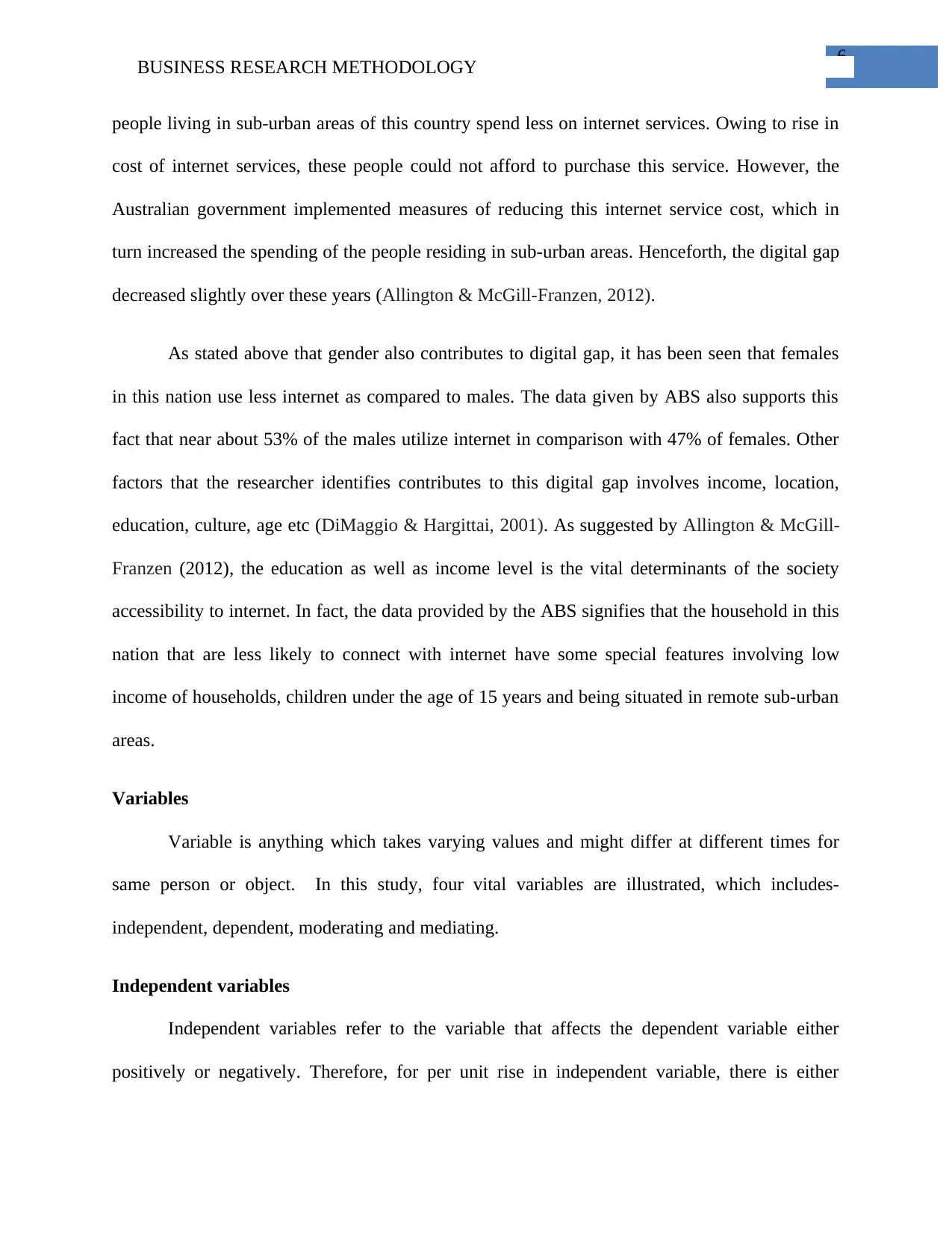
6
BUSINESS RESEARCH METHODOLOGY
people living in sub-urban areas of this country spend less on internet services. Owing to rise in
cost of internet services, these people could not afford to purchase this service. However, the
Australian government implemented measures of reducing this internet service cost, which in
turn increased the spending of the people residing in sub-urban areas. Henceforth, the digital gap
decreased slightly over these years (Allington & McGill-Franzen, 2012).
As stated above that gender also contributes to digital gap, it has been seen that females
in this nation use less internet as compared to males. The data given by ABS also supports this
fact that near about 53% of the males utilize internet in comparison with 47% of females. Other
factors that the researcher identifies contributes to this digital gap involves income, location,
education, culture, age etc (DiMaggio & Hargittai, 2001). As suggested by Allington & McGill-
Franzen (2012), the education as well as income level is the vital determinants of the society
accessibility to internet. In fact, the data provided by the ABS signifies that the household in this
nation that are less likely to connect with internet have some special features involving low
income of households, children under the age of 15 years and being situated in remote sub-urban
areas.
Variables
Variable is anything which takes varying values and might differ at different times for
same person or object. In this study, four vital variables are illustrated, which includes-
independent, dependent, moderating and mediating.
Independent variables
Independent variables refer to the variable that affects the dependent variable either
positively or negatively. Therefore, for per unit rise in independent variable, there is either
BUSINESS RESEARCH METHODOLOGY
people living in sub-urban areas of this country spend less on internet services. Owing to rise in
cost of internet services, these people could not afford to purchase this service. However, the
Australian government implemented measures of reducing this internet service cost, which in
turn increased the spending of the people residing in sub-urban areas. Henceforth, the digital gap
decreased slightly over these years (Allington & McGill-Franzen, 2012).
As stated above that gender also contributes to digital gap, it has been seen that females
in this nation use less internet as compared to males. The data given by ABS also supports this
fact that near about 53% of the males utilize internet in comparison with 47% of females. Other
factors that the researcher identifies contributes to this digital gap involves income, location,
education, culture, age etc (DiMaggio & Hargittai, 2001). As suggested by Allington & McGill-
Franzen (2012), the education as well as income level is the vital determinants of the society
accessibility to internet. In fact, the data provided by the ABS signifies that the household in this
nation that are less likely to connect with internet have some special features involving low
income of households, children under the age of 15 years and being situated in remote sub-urban
areas.
Variables
Variable is anything which takes varying values and might differ at different times for
same person or object. In this study, four vital variables are illustrated, which includes-
independent, dependent, moderating and mediating.
Independent variables
Independent variables refer to the variable that affects the dependent variable either
positively or negatively. Therefore, for per unit rise in independent variable, there is either
Paraphrase This Document
Need a fresh take? Get an instant paraphrase of this document with our AI Paraphraser
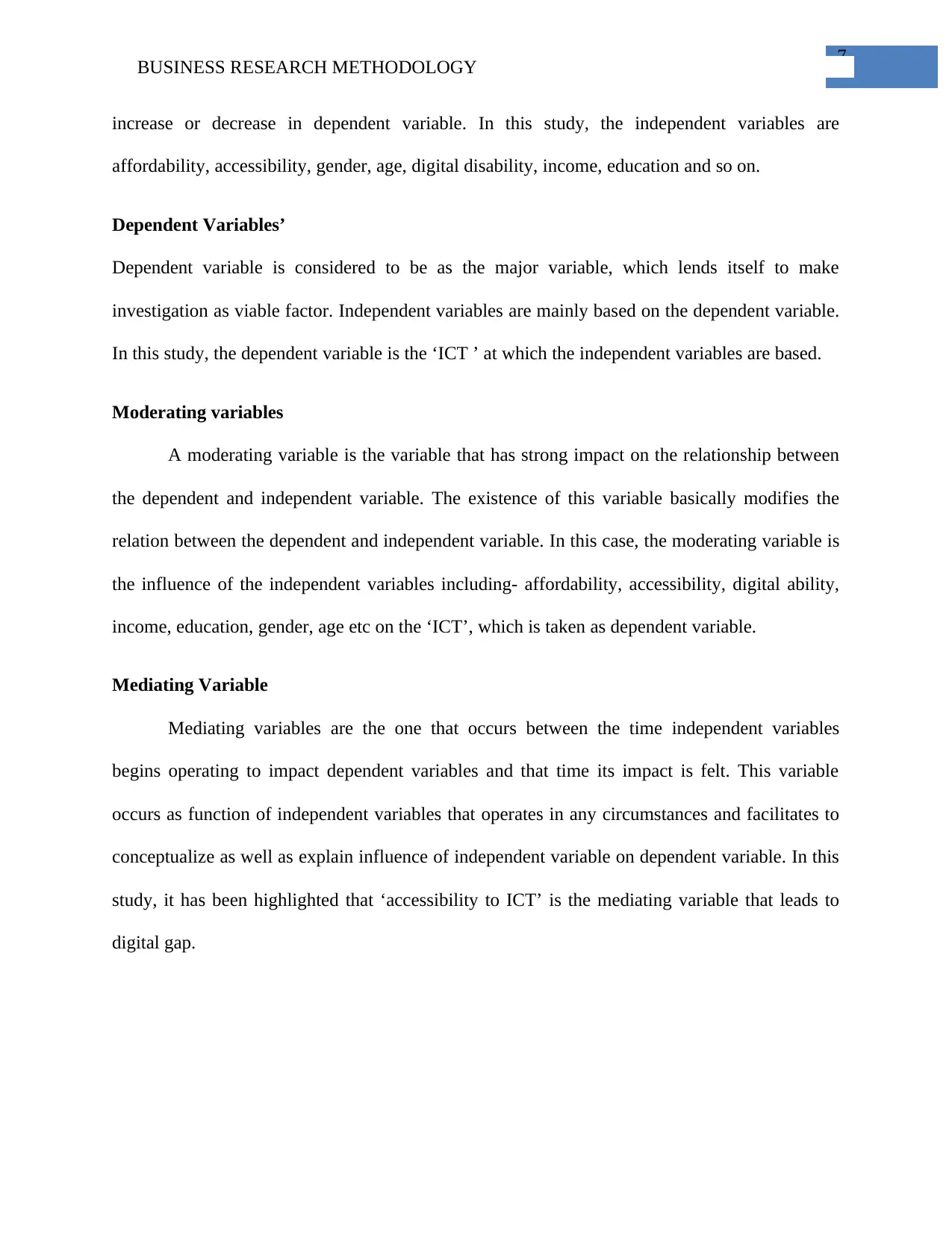
7
BUSINESS RESEARCH METHODOLOGY
increase or decrease in dependent variable. In this study, the independent variables are
affordability, accessibility, gender, age, digital disability, income, education and so on.
Dependent Variables’
Dependent variable is considered to be as the major variable, which lends itself to make
investigation as viable factor. Independent variables are mainly based on the dependent variable.
In this study, the dependent variable is the ‘ICT ’ at which the independent variables are based.
Moderating variables
A moderating variable is the variable that has strong impact on the relationship between
the dependent and independent variable. The existence of this variable basically modifies the
relation between the dependent and independent variable. In this case, the moderating variable is
the influence of the independent variables including- affordability, accessibility, digital ability,
income, education, gender, age etc on the ‘ICT’, which is taken as dependent variable.
Mediating Variable
Mediating variables are the one that occurs between the time independent variables
begins operating to impact dependent variables and that time its impact is felt. This variable
occurs as function of independent variables that operates in any circumstances and facilitates to
conceptualize as well as explain influence of independent variable on dependent variable. In this
study, it has been highlighted that ‘accessibility to ICT’ is the mediating variable that leads to
digital gap.
BUSINESS RESEARCH METHODOLOGY
increase or decrease in dependent variable. In this study, the independent variables are
affordability, accessibility, gender, age, digital disability, income, education and so on.
Dependent Variables’
Dependent variable is considered to be as the major variable, which lends itself to make
investigation as viable factor. Independent variables are mainly based on the dependent variable.
In this study, the dependent variable is the ‘ICT ’ at which the independent variables are based.
Moderating variables
A moderating variable is the variable that has strong impact on the relationship between
the dependent and independent variable. The existence of this variable basically modifies the
relation between the dependent and independent variable. In this case, the moderating variable is
the influence of the independent variables including- affordability, accessibility, digital ability,
income, education, gender, age etc on the ‘ICT’, which is taken as dependent variable.
Mediating Variable
Mediating variables are the one that occurs between the time independent variables
begins operating to impact dependent variables and that time its impact is felt. This variable
occurs as function of independent variables that operates in any circumstances and facilitates to
conceptualize as well as explain influence of independent variable on dependent variable. In this
study, it has been highlighted that ‘accessibility to ICT’ is the mediating variable that leads to
digital gap.
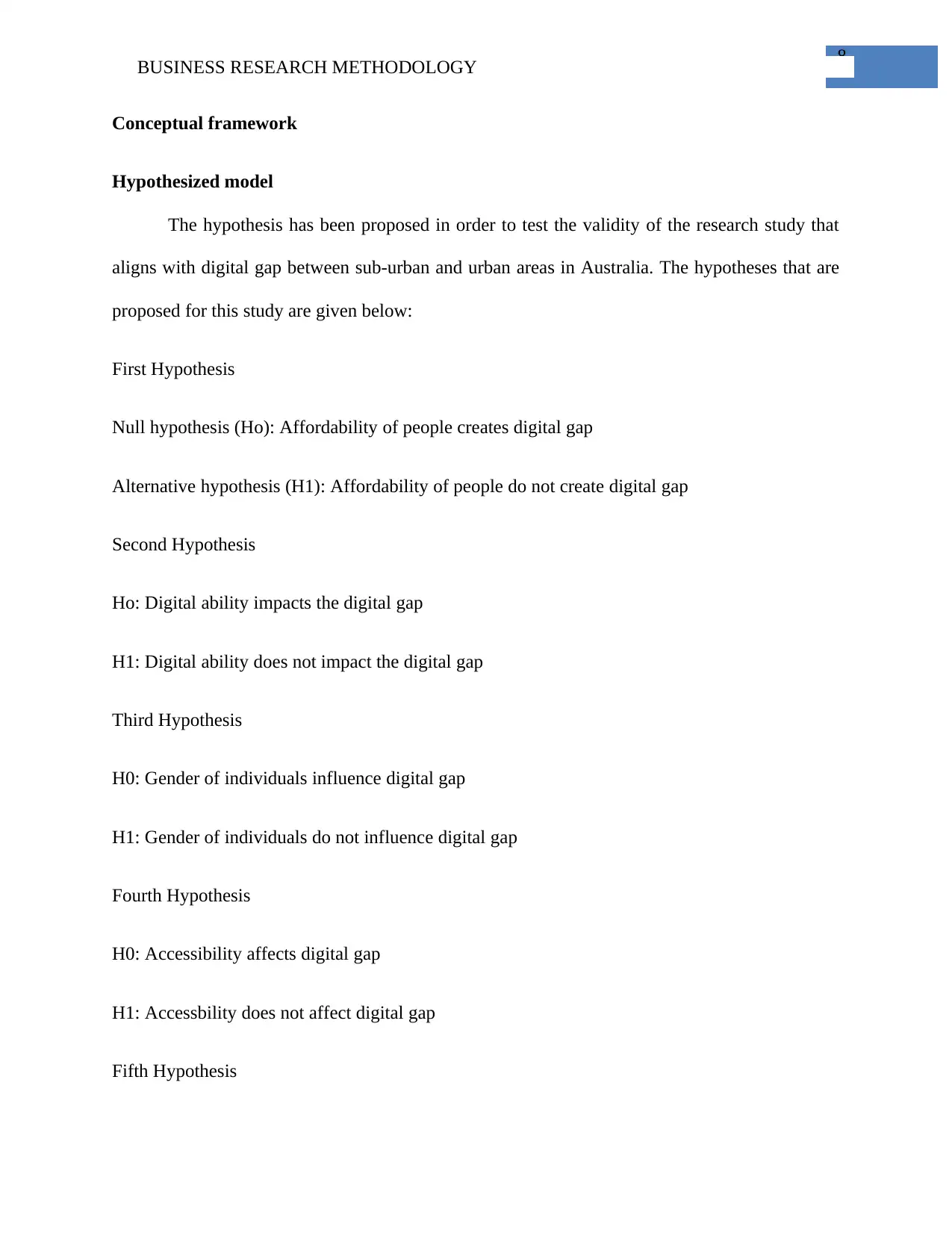
8
BUSINESS RESEARCH METHODOLOGY
Conceptual framework
Hypothesized model
The hypothesis has been proposed in order to test the validity of the research study that
aligns with digital gap between sub-urban and urban areas in Australia. The hypotheses that are
proposed for this study are given below:
First Hypothesis
Null hypothesis (Ho): Affordability of people creates digital gap
Alternative hypothesis (H1): Affordability of people do not create digital gap
Second Hypothesis
Ho: Digital ability impacts the digital gap
H1: Digital ability does not impact the digital gap
Third Hypothesis
H0: Gender of individuals influence digital gap
H1: Gender of individuals do not influence digital gap
Fourth Hypothesis
H0: Accessibility affects digital gap
H1: Accessbility does not affect digital gap
Fifth Hypothesis
BUSINESS RESEARCH METHODOLOGY
Conceptual framework
Hypothesized model
The hypothesis has been proposed in order to test the validity of the research study that
aligns with digital gap between sub-urban and urban areas in Australia. The hypotheses that are
proposed for this study are given below:
First Hypothesis
Null hypothesis (Ho): Affordability of people creates digital gap
Alternative hypothesis (H1): Affordability of people do not create digital gap
Second Hypothesis
Ho: Digital ability impacts the digital gap
H1: Digital ability does not impact the digital gap
Third Hypothesis
H0: Gender of individuals influence digital gap
H1: Gender of individuals do not influence digital gap
Fourth Hypothesis
H0: Accessibility affects digital gap
H1: Accessbility does not affect digital gap
Fifth Hypothesis
⊘ This is a preview!⊘
Do you want full access?
Subscribe today to unlock all pages.

Trusted by 1+ million students worldwide
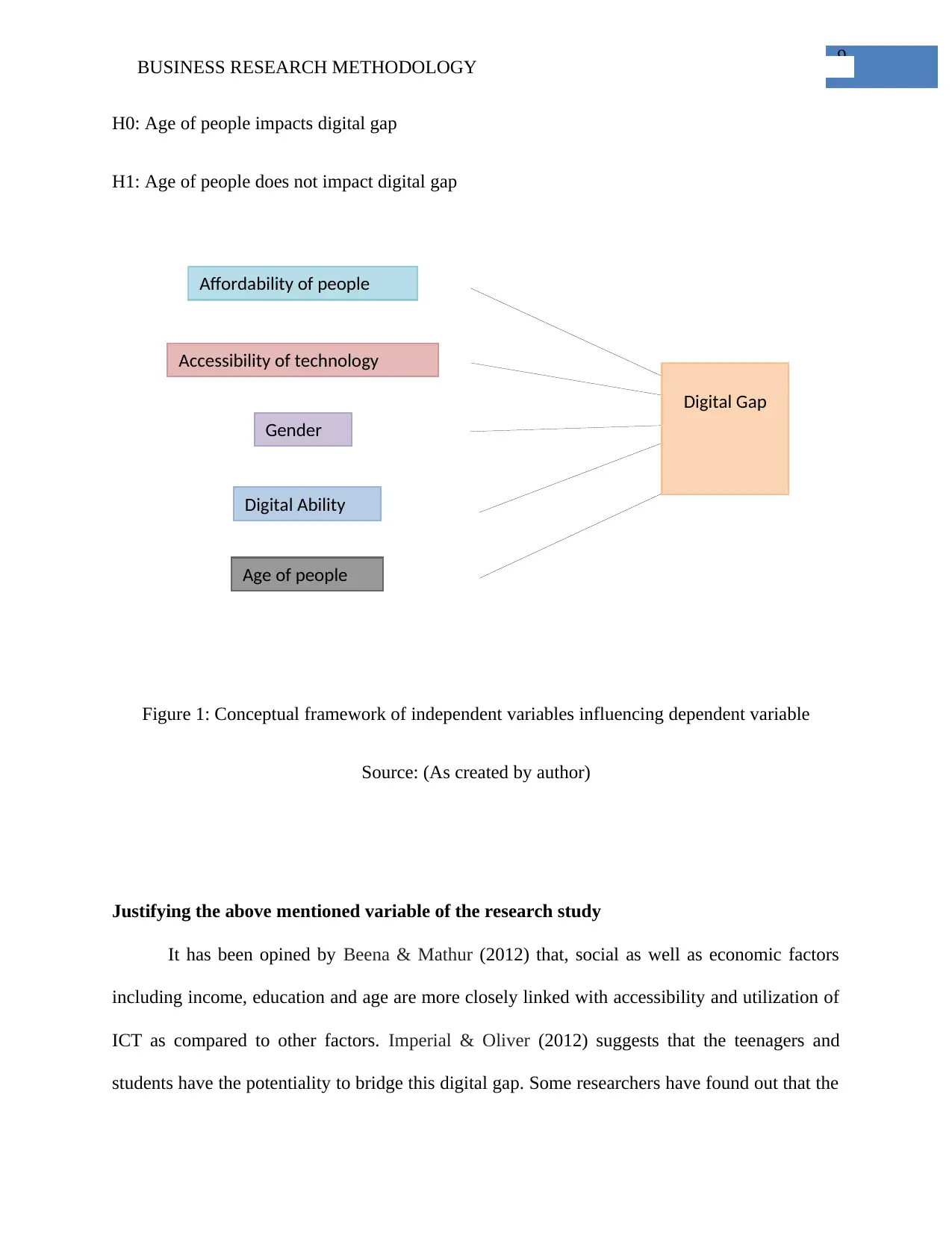
9
BUSINESS RESEARCH METHODOLOGY
Affordability of people
Accessibility of technology
Gender
Digital Ability
Age of people
Digital Gap
H0: Age of people impacts digital gap
H1: Age of people does not impact digital gap
Figure 1: Conceptual framework of independent variables influencing dependent variable
Source: (As created by author)
Justifying the above mentioned variable of the research study
It has been opined by Beena & Mathur (2012) that, social as well as economic factors
including income, education and age are more closely linked with accessibility and utilization of
ICT as compared to other factors. Imperial & Oliver (2012) suggests that the teenagers and
students have the potentiality to bridge this digital gap. Some researchers have found out that the
BUSINESS RESEARCH METHODOLOGY
Affordability of people
Accessibility of technology
Gender
Digital Ability
Age of people
Digital Gap
H0: Age of people impacts digital gap
H1: Age of people does not impact digital gap
Figure 1: Conceptual framework of independent variables influencing dependent variable
Source: (As created by author)
Justifying the above mentioned variable of the research study
It has been opined by Beena & Mathur (2012) that, social as well as economic factors
including income, education and age are more closely linked with accessibility and utilization of
ICT as compared to other factors. Imperial & Oliver (2012) suggests that the teenagers and
students have the potentiality to bridge this digital gap. Some researchers have found out that the
Paraphrase This Document
Need a fresh take? Get an instant paraphrase of this document with our AI Paraphraser
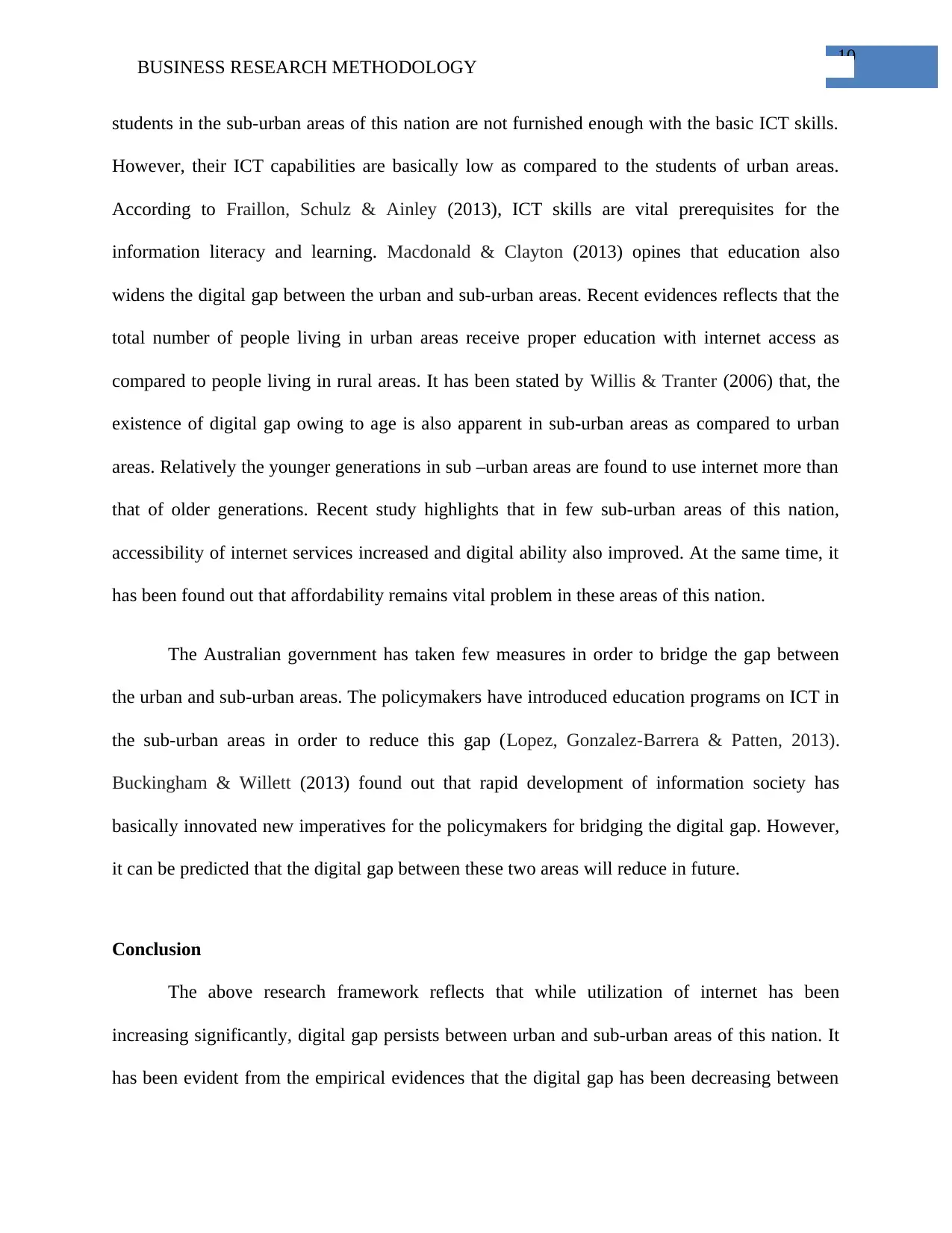
10
BUSINESS RESEARCH METHODOLOGY
students in the sub-urban areas of this nation are not furnished enough with the basic ICT skills.
However, their ICT capabilities are basically low as compared to the students of urban areas.
According to Fraillon, Schulz & Ainley (2013), ICT skills are vital prerequisites for the
information literacy and learning. Macdonald & Clayton (2013) opines that education also
widens the digital gap between the urban and sub-urban areas. Recent evidences reflects that the
total number of people living in urban areas receive proper education with internet access as
compared to people living in rural areas. It has been stated by Willis & Tranter (2006) that, the
existence of digital gap owing to age is also apparent in sub-urban areas as compared to urban
areas. Relatively the younger generations in sub –urban areas are found to use internet more than
that of older generations. Recent study highlights that in few sub-urban areas of this nation,
accessibility of internet services increased and digital ability also improved. At the same time, it
has been found out that affordability remains vital problem in these areas of this nation.
The Australian government has taken few measures in order to bridge the gap between
the urban and sub-urban areas. The policymakers have introduced education programs on ICT in
the sub-urban areas in order to reduce this gap (Lopez, Gonzalez-Barrera & Patten, 2013).
Buckingham & Willett (2013) found out that rapid development of information society has
basically innovated new imperatives for the policymakers for bridging the digital gap. However,
it can be predicted that the digital gap between these two areas will reduce in future.
Conclusion
The above research framework reflects that while utilization of internet has been
increasing significantly, digital gap persists between urban and sub-urban areas of this nation. It
has been evident from the empirical evidences that the digital gap has been decreasing between
BUSINESS RESEARCH METHODOLOGY
students in the sub-urban areas of this nation are not furnished enough with the basic ICT skills.
However, their ICT capabilities are basically low as compared to the students of urban areas.
According to Fraillon, Schulz & Ainley (2013), ICT skills are vital prerequisites for the
information literacy and learning. Macdonald & Clayton (2013) opines that education also
widens the digital gap between the urban and sub-urban areas. Recent evidences reflects that the
total number of people living in urban areas receive proper education with internet access as
compared to people living in rural areas. It has been stated by Willis & Tranter (2006) that, the
existence of digital gap owing to age is also apparent in sub-urban areas as compared to urban
areas. Relatively the younger generations in sub –urban areas are found to use internet more than
that of older generations. Recent study highlights that in few sub-urban areas of this nation,
accessibility of internet services increased and digital ability also improved. At the same time, it
has been found out that affordability remains vital problem in these areas of this nation.
The Australian government has taken few measures in order to bridge the gap between
the urban and sub-urban areas. The policymakers have introduced education programs on ICT in
the sub-urban areas in order to reduce this gap (Lopez, Gonzalez-Barrera & Patten, 2013).
Buckingham & Willett (2013) found out that rapid development of information society has
basically innovated new imperatives for the policymakers for bridging the digital gap. However,
it can be predicted that the digital gap between these two areas will reduce in future.
Conclusion
The above research framework reflects that while utilization of internet has been
increasing significantly, digital gap persists between urban and sub-urban areas of this nation. It
has been evident from the empirical evidences that the digital gap has been decreasing between
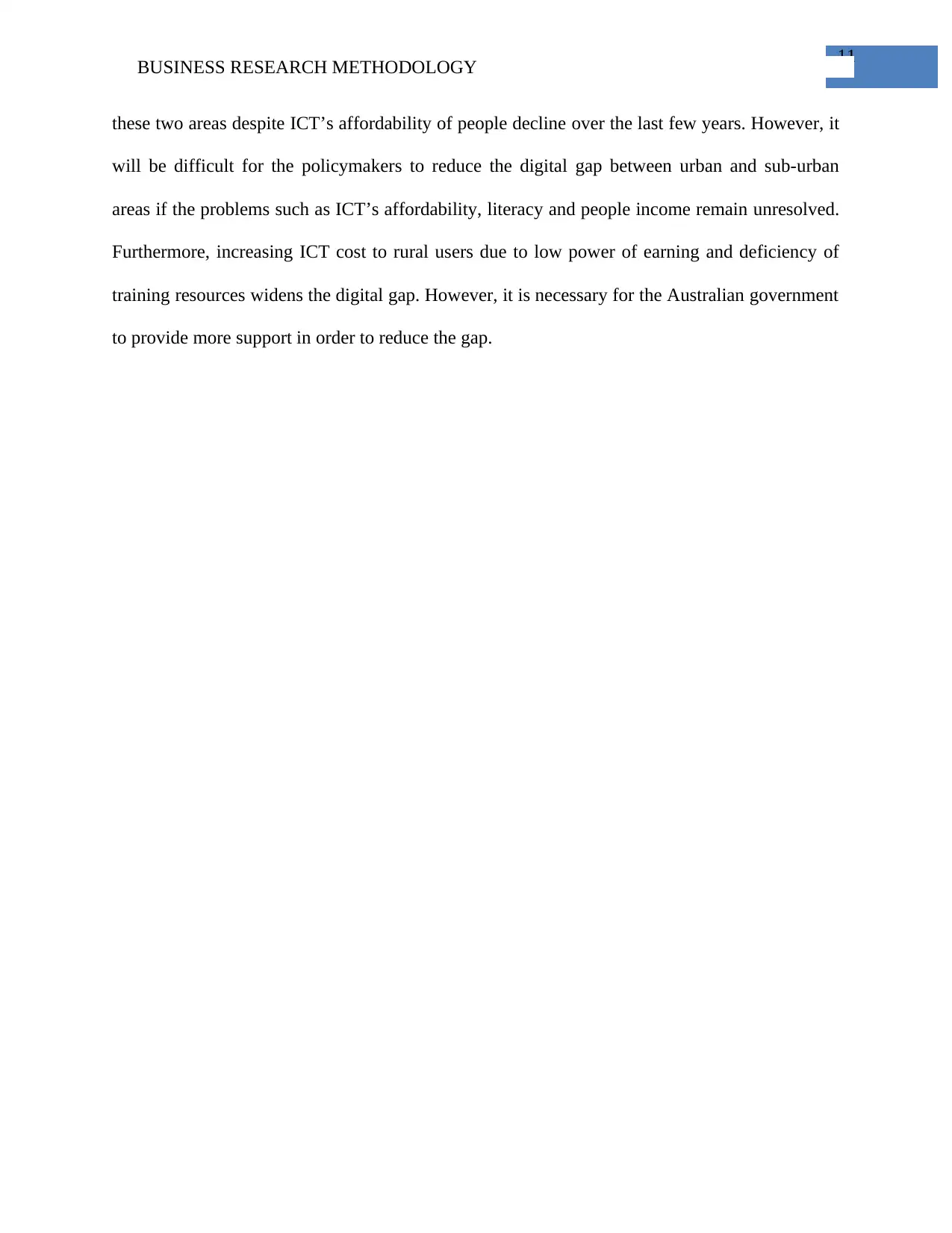
11
BUSINESS RESEARCH METHODOLOGY
these two areas despite ICT’s affordability of people decline over the last few years. However, it
will be difficult for the policymakers to reduce the digital gap between urban and sub-urban
areas if the problems such as ICT’s affordability, literacy and people income remain unresolved.
Furthermore, increasing ICT cost to rural users due to low power of earning and deficiency of
training resources widens the digital gap. However, it is necessary for the Australian government
to provide more support in order to reduce the gap.
BUSINESS RESEARCH METHODOLOGY
these two areas despite ICT’s affordability of people decline over the last few years. However, it
will be difficult for the policymakers to reduce the digital gap between urban and sub-urban
areas if the problems such as ICT’s affordability, literacy and people income remain unresolved.
Furthermore, increasing ICT cost to rural users due to low power of earning and deficiency of
training resources widens the digital gap. However, it is necessary for the Australian government
to provide more support in order to reduce the gap.
⊘ This is a preview!⊘
Do you want full access?
Subscribe today to unlock all pages.

Trusted by 1+ million students worldwide
1 out of 14
Related Documents
Your All-in-One AI-Powered Toolkit for Academic Success.
+13062052269
info@desklib.com
Available 24*7 on WhatsApp / Email
![[object Object]](/_next/static/media/star-bottom.7253800d.svg)
Unlock your academic potential
Copyright © 2020–2025 A2Z Services. All Rights Reserved. Developed and managed by ZUCOL.




